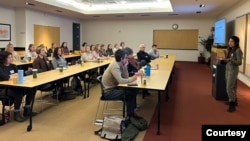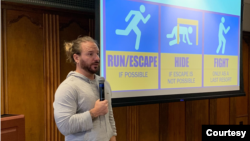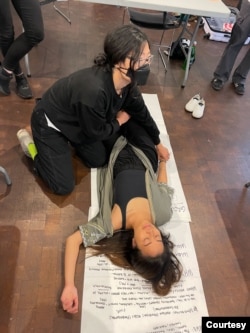Journalists reporting on the U.S. presidential election are facing significant physical and digital threats, says a media support group.
Data released by the International Women’s Media Foundation, or IWMF, found that with just five months to November 5, more than 37% of journalists have been threatened with physical violence and 30% say they were threatened online.
The data is taken from a survey of more than 350 local journalists covering politics in eight swing states in the country. Those represented had taken part in newsroom safety workshops that the IWMF provided.
The main areas of concern cited in the survey were threats, attacks or arrests at campaign rallies or protests, the survey found.
Another issue is digital violence from right-wing extremist groups, said Nadine Hoffman, deputy executive director at IWMF.
“Nearly 40 percent of the 350+ journalists we’ve trained in the U.S. this year reported threats of or experiencing physical violence; 30% reported digital threats and attacks; 27% experienced legal threats,” Hoffman told VOA via email.
To help newsrooms better prepare for election coverage, the IWMF provided safety training in Arizona, Georgia, Michigan, New York, Nevada, North Carolina, Pennsylvania, and Wisconsin.
“We have upcoming training planned in Illinois and California. We’ll also be offering safety training at journalism conferences across the country this summer,” said Hoffman.
The organization believes that newsroom leaders need to instill a culture of safety to protect their reporters — including freelancers — from a range of threats.
“Risk is not one size fits all, and editors need to have open and honest conversations before sending their reporters into the field about how best to mitigate the risk they face,” Hoffman said.
“For example, journalists of color, LGBTQI+ reporters, and women may face a greater risk of harassment both online and offline,” she added.
Data released by the Pew Research Center in June 2022 found more than a quarter of Black and Asian journalists and around a fifth of Hispanic journalists say they have experienced threats or harassment that centers on their race or ethnicity.
“I believe that press freedom depends on a diversity of voices and perspectives, and we need to offer more support to the journalists most at risk of being attacked based on their identities, so they are more likely to stay in the profession,” said Hoffman.
A rise in hostility toward the media in recent years led to workshops being offered on journalism safety for reporters inside the U.S.
“The journalists face threats all year round, which is why our training is necessary,” said Hoffman. She added that the IWMF is joining with the Reporters Committee for Freedom of the Press to include sessions on legal rights for media.
The U.S. Press Freedom Tracker, which since 2017 has collected data on arrests, attacks and threats to journalists in the U.S., has documented an increase in threats to the media during elections.
“Election season is not the only time when journalists face threats considering the profession but there is an increase in the intensity of threats like physical violence, targeted interference, and online harassment during this time,” said Harlo Holmes, head of digital security at the Freedom of the Press Foundation. The foundation oversees the Tracker, which was founded by a coalition of press freedom organizations.
“I believe that an ounce of prevention is better than a pound of cure, especially when it comes to the safety of journalists,” Holmes added.
News crews should have a plan for if a situation escalates or turns violent. And journalists should clean up their online footprints to make sure personal information isn’t easily available to trolls, Holmes said.
The IWMF’s Hoffman said newsrooms can better prepare with simple measures like the buddy system for teams, setting up a communications plan, and having crews check in at agreed-upon times with their editors when they’re on a potentially risky assignment like covering a protest or rally.
Emphasizing the risk to mental health of journalists, Hoffman further suggests that the newsrooms should take trauma seriously. Covering school shootings, civil unrest or police brutality takes a toll, she said.













